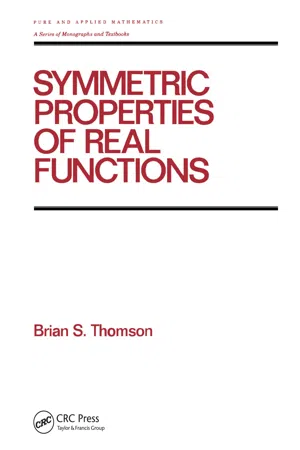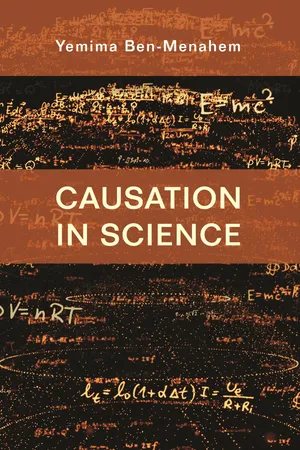Mathematics
Symmetry of Functions
Symmetry of functions refers to the property of a function to remain unchanged when certain transformations are applied. These transformations include reflection, rotation, and translation. A function can exhibit different types of symmetry, such as even, odd, or periodic symmetry.
Written by Perlego with AI-assistance
3 Key excerpts on "Symmetry of Functions"
Learn about this page
Index pages curate the most relevant extracts from our library of academic textbooks. They’ve been created using an in-house natural language model (NLM), each adding context and meaning to key research topics.
- eBook - ePub
- Brian thomson(Author)
- 2020(Publication Date)
- CRC Press(Publisher)
6 Odd Properties6.2 Introduction
In this chapter we complete a systematic study of the odd properties of real functions. We recall that the study of the odd properties of a function reveals its even symmetric structure. At the simplest level a function is even if and only if its odd part vanishes. Similarly a greater or lesser degree of control on the behavior of the odd part of a function expresses some characteristic of its even symmetric structure.The symmetry properties that we propose now to study all concern the nature of a function f that satisfies some requirement on the size of the expression.f( x + h )− f( x − h )( as h → 0 )For example the most severe requirement is to ask that at each point x there is a neighbourhood in which the symmetry f (x + h ) = f (x − h ) holds. We shall say a function f is exactly locally symmetric at x if this holds. One expects that this vanishing odd part, giving a local even symmetry at each point, should arise only for a function that is symmetric about every vertical line (i.e. a constant function). This is very nearly the case and leads to some interesting results. A much weaker requirement might be to ask only that( f( x + h )− f( x − h )) / 2 hremain bounded as h → 0; a function with a symmetric derivative would have this property. We have already encountered some results of this type in the first two chapters and we have seen a large collection of analogous problems stated in terms of even properties in Chapter 4 . While there are parallels in the behavior of the odd and even properties our study reveals a broad range of differences and introduces different techniques.Properties relating more directly to the symmetric derivatives themselves will be studied in Chapter 7 .6.2 Symmetry
We begin our study with exact symmetry conditions. A set E would be exactly symmetric at a point x if the condition x + h ∈ E is equivalent to x — h ∈ E . A function would be exactly symmetric at a point x if there is an identity f (x +h ) = f (x −h - eBook - ePub
- Michael Hvidsten(Author)
- 2016(Publication Date)
- Chapman and Hall/CRC(Publisher)
CHAPTER 6Symmetry
Tyger, Tyger, burning bright,In the forests of the night;What immortal hand or eye,Could frame thy fearful symmetry? – “The Tyger” by William BlakeIn Chapter 1 we saw how our axiomatic and abstract understanding of geometry had its origins with the Greeks’ desire for perfection of reasoning. This goal of the “ideal” permeated all aspects of Greek culture, as evidenced by their love of the golden ratio—the perfect harmony of proportion. Western cultures have embraced this love of harmony and balance, as evidenced by a focus on symmetry in art, music, architecture, and design.In the preceding chapter, isometries were used to define several types of symmetry . Symmetry is a common property of both natural and man-made objects.In general, given a geometric figure F , we will call a transformation f a symmetry of F if f maps F back to itself. That is, f (F ) = F . We say that F is invariant (or unchanged) under f . Note that this does not mean that every point of F remains unchanged, only that the total set of points making up F is unchanged.Given a figure such as a flower, or snail shell, or triangle, the set of all symmetries of that figure is not just a random collection of functions. The set of symmetries of an object has a very nice algebraic structure.Theorem 6.1 . The set of symmetries of a figure F forms a group.Proof: Recall that a group is a set of elements satisfying four properties (refer to the discussion preceding Exercise 1.4.6 ). For a set of functions, these properties would be:- Given any two functions in the set, the composition of the two functions is again in the set.
- The composition of functions is an associative operation.
- The identity function is a member of the set.
- Given any function in the set, its inverse exists and is an element of the set.
To prove that the set S of symmetries of F forms a group, we need to verify that S - eBook - ePub
- Yemima Ben-Menahem(Author)
- 2018(Publication Date)
- Princeton University Press(Publisher)
Symmetry and equivalence are likewise closely related: when we have symmetry, the original and the transformed states are equivalent in some specified sense, as, for instance, when the two states are equally probable, or when both are solutions to the same equation. Hence symmetries, like equivalence relations, generate partitions into equivalence classes. Upon the development of group theory in the nineteenth century, it became clear that symmetries form groups that can serve to characterize them. 4 It was later proved that the converse is also the case: every group is a symmetry group of a certain graph (Frucht 1939). In physics, the symmetries of laws, or of the equations expressing laws, are of particular interest. Symmetries are manifestations of what remains invariant in the process described by the law or equation in question. The connection between symmetry and equivalence makes it clear that symmetries also indicate which properties and parameters are, from the physical point of view, irrelevant. To give the simplest example, if spatial or temporal translation is a symmetry of the (Euler-Lagrange) equations of motion, this means that absolute position in space or time (as opposed to relative position) cannot make a physical difference to any evolution governed by these equations. Even at this preliminary stage, we have some insight into the relation between symmetries and causation in the broad sense. For although symmetries are expressed as mathematical properties of mathematical objects—the equations of motion, say—under their physical interpretation, they express constraints on change, and distinguish properties that are deemed to make a physical difference from those that are deemed to make no difference. Note that there is no purely mathematical reason why absolute position in space or time should make no physical difference


